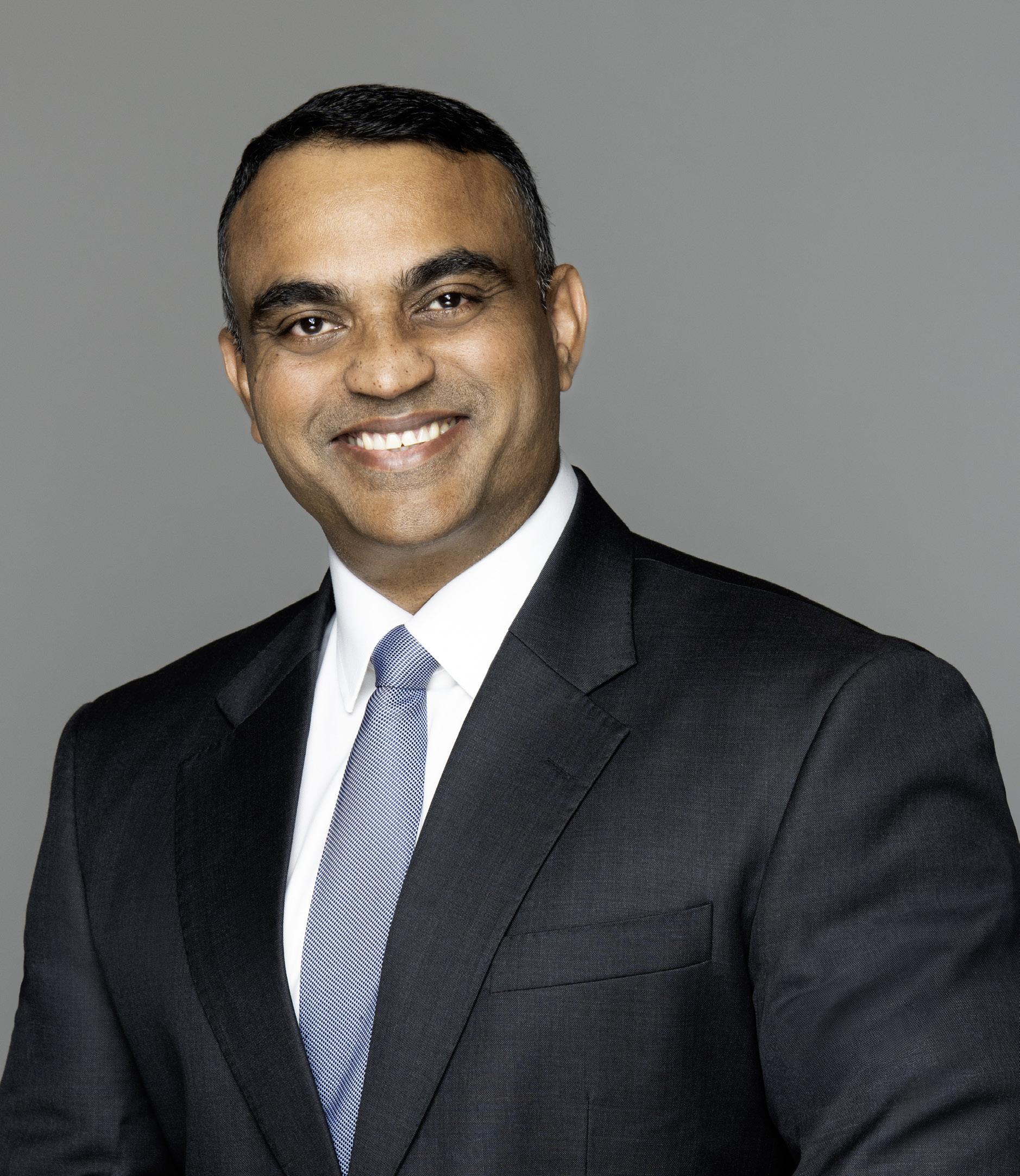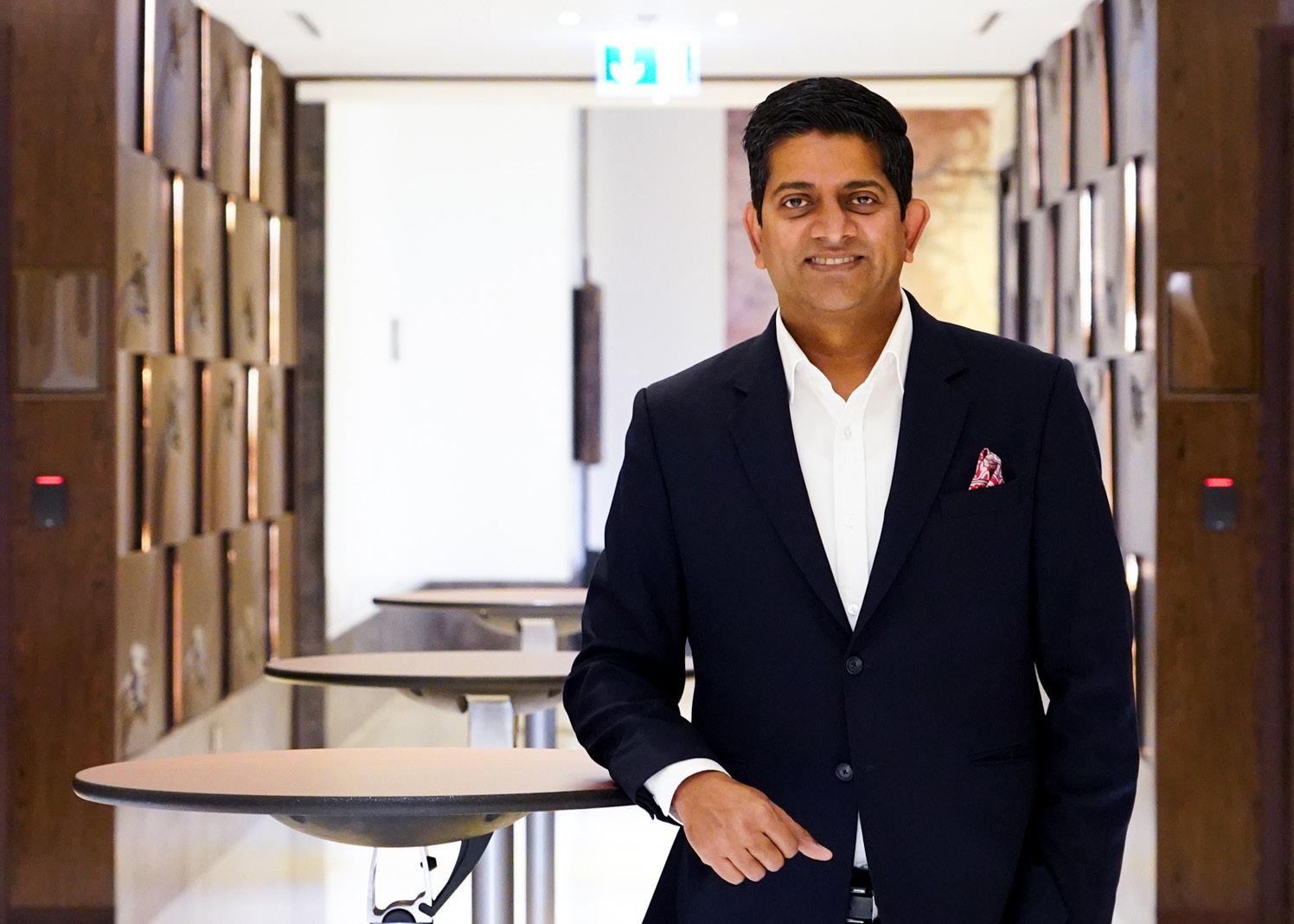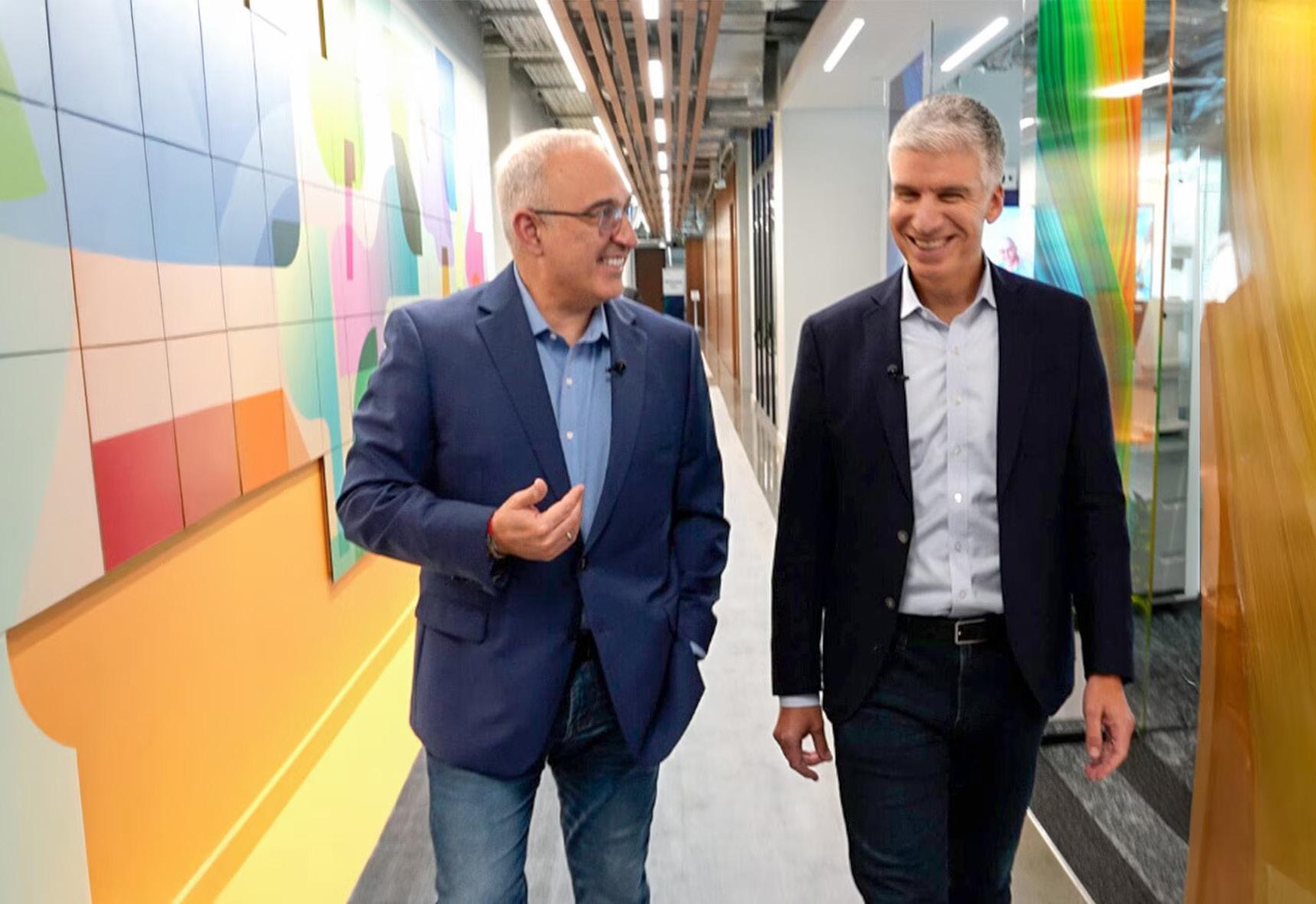A
Traditional networks, designed for more static, predictable traffic patterns, are ill-suited for this level of complexity.
“AI is changing the game for networking,” says Jacob Chacko, Regional Director for Middle East and Africa, HPE Networking. “You’re no longer dealing with conventional traffic. It’s massive data flows, real-time processing, and workloads that span hybrid and multi-cloud environments.”
Enterprise networks are now expected to flex and adapt continuously. Yet, many
organisations still rely on manual processes and fragmented architectures. This creates blind spots, bottlenecks, and a growing operational burden for IT teams.
“Networks have grown more diverse, and managing them the old way simply doesn’t scale,” Chacko explains. “That’s where AI comes in—not just to carry AI workloads, but to run the network itself more intelligently.”
HPE Aruba Networking’s use of AIOps—applying AI to IT operations—enables 24/7 monitoring, early detection of anomalies, and predictive insights that allow teams to resolve issues before users are impacted. By applying machine learning and analytics to network telemetry, the system continuously optimises performance and reduces human error.
The result is a smarter, more autonomous network that improves security, boosts efficiency, and frees up IT teams to focus on strategy rather than firefighting. “AI is no longer a future concept in networking, it’s already here and it’s transforming operations today,” says Chacko.
“AI is redefining the rules, and we’re building the infrastructure to match”
As demand surges for AI-enabled services, service providers and telcos are facing immense pressure to modernise infrastructure quickly and at scale. “To monetise the AI opportunity, their networks must evolve—not just incrementally through bandwidth upgrades, but fundamentally by adopting cloud-native architectures, embedding AI at the core, and building the agility to support realtime, distributed workloads at scale,” Chacko explains.
Emerging capabilities like network slicing, AI inferencing at the edge, and cloudification of core network functions are opening the door to new services and revenue models. But this requires a level of agility and observability that legacy systems can’t deliver.
“We’re helping telcos refocus on core connectivity and integrate AI across the stack—so they can move faster, be more efficient, and deliver a better customer experience,” says Chacko. “That’s where the growth is.”
Juniper + HPE: The rise of a new era in AI and networking
In July 2025, Hewlett-Packard Enterprise (HPE) closed its $14 billion acquisition of Juniper Networks—a move that marks a bold step forward in its networking strategy. The deal not only doubles HPE’s networking business, but also strengthens its ability to deliver AI-native infrastructure across the enterprise, telco, and cloud markets.
“The timing couldn’t be better,” says Chacko. “I’m thrilled to now be leading the Juniper networking business as well—bringing together Juniper’s cloud-native and AI-driven capabilities, especially Mist AI, with HPE Aruba Networking’s edge-to-cloud foundation. We now have a unified architecture that’s built to handle what’s coming.”
Jacob Chacko, HPE Networking
Hospitality renaissance: How intelligent connectivity is redefining experiences
As Middle East hospitality players shift from service to smarter experiences, Petvin Fernandes, CEO of The Hospitality Network, shares how AI and connected technologies are reshaping the industry
The hospitality sector in the Middle East is entering a transformative phase. In 2024, Dubai alone welcomed 18.72 million international visitors—a nine percent yearon-year increase—while hotel occupancy across the GCC rose to 69.5 percent, exceeding pre-pandemic levels. As development surges in markets like Saudi Arabia and the UAE, hotel operators are turning to technology—particularly artificial intelligence—to deliver more intuitive and impactful guest experiences.
“Hotels are leveraging artificial intelligence to deliver personalised experiences, from tailored recommendations to customised services, fostering deeper engagement and higher guest loyalty,” says the Petvin Fernandes, CEO, The Hospitality Network.
With Millennials and Gen Z set to account for a significant share of global hospitality spend, expectations around digital convenience and personalisation have never been higher.
From AI-powered concierges and voice assistants to tour guide bots, the use of AI is no longer confined to behindthe-scenes operations—it’s becoming a core part of the guest journey. “Solutions such as AI concierge provide instant,
expert and personalised interactions. The development of AI powered tour guides takes the adoption of technology beyond the confines of the property,” he adds.
Smart room technologies are also gaining traction, giving guests control over lighting, temperature, and entertainment through seamless digital interfaces. At the same time, automated check-in and check-out are helping reduce queues and improve operational efficiency. These experiences are aligned with what today’s traveller demands: frictionless, customised, and tech-enabled stays.
The shift is also reflected in spending patterns. According to a recent study, the AI in hospitality market is expected to see exponential growth in the coming years, projected to reach $1.46 billion by 2029—an indication of the technology’s growing influence on both guest satisfaction and backend efficiency.
However, the effectiveness of AI is only as strong as the infrastructure supporting it. “HPE Aruba has been an active sponsor of our annual Stakeholder Conferences since our inception, and through showcasing their uniquely positioned products and expertise, they play a key role
in supporting the adoption of technology to transform hotels,” he says.
Jacob Chacko, Regional Director for Middle East and Africa, HPE Networking, adds, “The hospitality industry is one of the most dynamic and experience-driven sectors, and it’s constantly evolving. Across the region, we’re partnering on some of the most ambitious hotel projects, ensuring they are built on a strong, secure digital foundation. AI-powered networking is redefining how hotels connect—not just
systems and services, but people and experiences. For modern hospitality players, network infrastructure must go beyond basic connectivity to enable intelligent, seamless experiences that meet the expectations of today’s connected traveller. And that’s what we’re trusted to deliver.”
Through its events and community-building efforts, The Hospitality Network plays a facilitative role by connecting industry leaders with emerging technologies. “We’ve built a unique community for
“We aim to inspire creativity and keep access open to the latest innovations available in the market…”
Petvin Fernandes, The Hospitality Network
networking, the sharing of expert insights and the very hands-on exploration of innovation. We aim to inspire creativity and keep access open to the latest innovations available in the market, giving industry leaders the connections and knowledge to adopt new technologies in their properties.”
For hospitality leaders seeking to stay ahead of the curve, he offers clear guidance: “My advice to hospitality leaders who want to future-proof their properties is to stay active and be continually learning. Attending conferences and events that give access to the latest products and solutions is imperative, as well as picking the right partners who will take the time to truly understand their unique situation and guide them to the best approach.”
As the Middle East’s hospitality sector expands at an unprecedented pace, technology is playing a pivotal role in shaping its next chapter. Whether it’s elevating the guest experience, optimising daily operations, or supporting the rollout of smart, connected environments, innovation is now deeply embedded in how hotels operate and grow.
Petvin Fernandes, The Hospitality Network
Al-Nassr Club Company redefines fan engagement with Hewlett
Packard Enterprise
The initiative aims to transform fan engagement with secure, high-performance infrastructure powering content, streaming, and match-day experiences
Being at the forefront of Saudi Arabia’s footballing ambitions, Al-Nassr Club Company, one of the leading football clubs in the Kingdom, is working with Hewlett Packard Enterprise (HPE) to transform its stadium, training, medical, media, and fan facilities – and thereby the way fans engage with football. Key to this experience is a comprehensive end-to-end solution, built on HPE Aruba Networking, that establishes a coherent, performance-focused and secure network infrastructure. Throughout the past few years, Al-Nassr has become the most-followed team by football fans outside Saudi Arabia. Aware that not everyone who watches an Al-Nassr match will be able to travel to Saudi Arabia to attend games, and that more than 60 million fans follow their games, Al-Nassr wants to redefine the fan experience with more content, more behind-the-scenes footage, and
greater access to star players.
To drive digital content, AlNassr is creating a digital sports campus, creating a wireless-first environment engaging both fans within and outside the stadium.
“We always have a minimum of 300–400 people connecting to the network on quiet days, however the number jumps to more than 10,000 on match days,” said Faisal Khan, Director of IT at Al-Nassr.
“Simultaneously, we are filming
throughout the week, across all parts of the organisation. The fan engagement and content we provide goes beyond the match-day experience and with HPE Aruba Networking we are now able to scale and allocate different bandwidth, manage access rights for different user groups, and troubleshoot connectivity issues easily, all from the office.”
The solution deployed at the sports campus combines
“The fan engagement and content we provide goes beyond the matchday experience and with HPE Aruba Networking we are now able to scale and allocate different bandwidth, manage access rights for different user groups, and troubleshoot connectivity issues easily, all from the office”
infrastructure exposed via MCP, AI agents can proactively request compute, storage, or network resources and adjust based on resource availability. This reduces cost, optimizes performance, and ensures SLA alignment.
Example IT operations agentic workflow
Let’s see a quick example of agents working together to deliver a desired outcome through a typical agentic workflow.
agents with the situational awareness they need to make intelligent decisions based on real-time infrastructure metrics and business logic.
Whether you’re attempting to retrieve data from an HPE Alletra Storage MP X10000 storage array or provision a Kubernetes cluster for a mission-critical application, or understand the experience of a user on Wi-Fi, the agents orchestrate to deliver on the task requested.
Inter-agent communication MCP standardizes the language of collaboration between distributed agents.
For example, a model detecting anomalous behavior in financial data can request enhanced resources from another agent responsible for dynamic workload orchestration— creating an emergent system of shared intelligence.
• Infrastructure-aware models
With GreenLake
the capabilities of HPE Aruba Networking Central, HPE Aruba Networking CX switches, HPE Aruba Networking EdgeConnect SD-WAN, and HPE Aruba Networking Wi-Fi 7 wireless access points. This allows the club’s IT team to closely manage the various fan engagement points, keep sensitive biometric data of players secure, and quickly provide connectivity to new parts of the campus.
The club manages connectivity for 20 buildings, including warehousing and retail outlets, with more stores and branch offices expected as the club expands its operations. By using HPE Aruba Networking EdgeConnect SD-WAN, the club can use multiple connections to provide high availability and resilience, even in times of high use. This increases performance by link-binding and maximising the use of available bandwidth, making it particularly valuable to the football club for critical
Example: IT Operator makes a request through their GreenLake intelligence chatbot prompt to Provision 20 VMs each with 2 vCPUs attached to 2T of storage on VLAN1.
For more detailed examples, please read the whitepaper highlighted in the bottom of this blog.
Why it matters Modern IT environments are complex and demanding. GreenLake Intelligence helps tackle common IT challenges: Limited IT organisations: Complex hybrid environments strain operational teams. AI agents monitor and manage crossdomain business problems like cost and security, freeing teams to focus on innovation. Complex environments: With multiple generations
4 CONTINUED
applications, such as video live streaming matches.
“As Al-Nassr continues to realise and enhance its vision for fan engagement and data commercialisation, it needs a robust and performancefocused networking infrastructure”, said Jamil Ahmad, Country Business lead for Saudi Arabia at HPE Aruba Networking. “By building a smart sports campus upon HPE Aruba Networking, Al-Nassr has unified and streamlined its networking operations, maximising opportunities for content generation and simplifying the deployment of game-changing IoT. This includes the club’s media streaming capabilities, that allow fans to not only watch video streams of games and player interviews from different parts of the world but also stream exclusive content on their smartphone within the stadium – creating a one-of-akind experience.”
Faisal Khan, Al-Nassr Club Company
Faisal Khan, Al-Nassr Club Company Jamil Ahmad, HPE Aruba Networking
Changing the game for customers: HPE’s acquisition of Juniper
Networks offers compelling network alternative
By: Antonio Neri, President & CEO,
HPE
I am thrilled to announce the successful close of HPE’s acquisition of Juniper Networks, creating a powerful combination of two bestin-class networking portfolios. Together, we will now deliver a truly comprehensive cloud-native IT portfolio supported by agentic AI operations – including a modern, secure and AI-native network –that delivers on the promise of hybrid cloud and AI.
Networking’s role as the connective fabric for the enterprise has never been more relevant. The network is the core foundation of a hybrid IT infrastructure, and the world today requires a strong innovator at scale. Our acquisition underscores the imperative of networking as we enter a new era in IT defined by the unprecedented convergence of networking, hybrid cloud, and AI.
Networking’s vital role in the age of AI
Over the past two decades, the number of users, devices, and applications – and the volume of data they create – have grown exponentially. This has introduced significant complexity and made network performance and security much harder to manage. At the same time, AI has introduced the biggest technology disruption of this generation.
AI relies on vast, distributed datasets that must be connected securely and sustainably to train or fine-tune foundational or agentic models, and to deploy them for inferencing. That means the network must do more than simply connect users, servers, and storage. It must adapt, scale, and continually become more intelligent. Put simply, the network is every bit as important as the silicon in unlocking the power and value AI holds.
What’s ahead
HPE and Juniper have come together at a critical time to provide an industry leading secure, AI-native network, purpose-built with AI and for AI, to deliver exceptional user and operator experiences. Our differentiation is built on three pillars: AI-native operations: With first-of-its-kind multivendor agentic AI operations, the combined networking solution is built on more than 10 years of data science and has over 80% efficacy. No other network provider offers multivendor AI ops, with continuous learning in a large experience model. And this is part of the GreenLake cross-domain operations cloud service. Complete client-to-cloud network portfolio: Our new end-to-end network portfolio has robust hardware across all domains (enterprise, service provider, and cloud), managed by a single cloud-native management platform with on-premises and virtual private cloud options. This gives customers reliable, consistent end-to-end performance that supports a great user experience and a simplified operator experience.
• Integral security: HPE offers a complete security portfolio unified under common management (NAC, SSE, Firewall). We are the first to converge network and security management via a common UI and AI engine, delivering consistent user experiences in all locations, saving time and money, and increasing accuracy.
Whether building the right network to pursue strategic AI initiatives or using AI to optimise network ops, customers will benefit from both HPE Aruba Networking and HPE Juniper Networking products and solutions that are part of a next-generation technology architecture to deliver the power, performance, and ease of management that AI requires.
I am incredibly excited about what this combination will mean for our customers, partners, team members, and shareholders. As a result of both teams’ efforts over the last 18 months to prepare for this day, we are well positioned to swiftly integrate HPE and Juniper and we look forward to sharing key milestones as we progress. Both companies share core values rooted in collaboration, innovation, and customer-centricity, creating a strong foundation that will enable our customers to quickly unlock value from the combination.
With this acquisition, HPE is leading a monumental IT transformation to push the boundaries of what is possible. The road ahead is full of promise, and we are excited to lead the way.
4 CONTINUED FROM PAGE 1
The integration of Mist AI into the HPE Aruba Networking portfolio means customers gain advanced automation, deeper insights, and a more intuitive management experience. Juniper’s strength in routing and data centre networking complements HPE Aruba Networking’s leadership in campus and edge environments—creating one of the most complete stacks in the market.
This new combined portfolio offers clear benefits for customers seeking to modernise their networks: enhanced performance, simplified operations, improved security, and better alignment with AI-intensive workloads. “We’re bringing together the best of both worlds,” Chacko adds. “And doing it in a way that’s practical, scalable, and future-ready.”
4 CONTINUED FROM PAGE 3
GreenLake Intelligence...
of technology installed in an organisation, and multiple suppliers of hardware and software, keeping a unified picture of resource consumption, user experience, or even end-toend status, is challenging, and drives up operational costs.
Ineffective root cause analysis: Fragmented tools slow down issue resolution.
GreenLake Intelligence’s AI agents detect, analyze, and assist the operator to resolve problems across domains in real time.
• Resource utilisation: Idle assets and inefficiencies drain resources. GreenLake Intelligence identifies and optimizes cost, performance, and sustainability automatically.
Conversational interaction with GreenLake Copilot Users interact with GreenLake Intelligence through a generative AI conversational interface called GreenLake Copilot. Entering clear commands where intelligent assistants understand intent and coordinate behind the scenes, GreenLake Copilot translates these interactions into real-time actions, delivering clear, contextual, and personalized responses aligned with your IT operations goals.
“We’re bringing together the best of both worlds and doing it in a way that’s practical, scalable, and future-ready”
The move also positions HPE as a serious challenger in a market long dominated by a few legacy players. But rather than trying to outpace competitors on legacy terms, HPE is carving a new path—one rooted in AI, cloudnative principles, and open ecosystems.
“This isn’t about catching up—it’s about leading in a new
How is this different from traditional IT operations? Traditional IT operations management (ITOM) is often manual, reactive, and toolcentric, relying on dashboards, tickets, and human-driven processes. GreenLake Intelligence, by contrast, is autonomous, proactive, and goal-driven. Here’s how it compares: GreenLake Intelligence goes beyond ITOM by enabling AI agents to observe, reason, and act in real time, delivering actionable recommendations or automated resolutions with your permission.
The power of AI agents HPE is developing a wide range of AI agents spanning infrastructure (e.g., storage, networking, VMs), operations (e.g., cost, observability, sustainability), and business services (e.g., ticketing, reporting). These agents collaborate within the agentic mesh, sharing context and correlating anomalies to deliver deep, cross-domain insights. For example, a performance issue in a business application might stem from a storage bottleneck caused by a misrouted network path. GreenLake Intelligence can trace this chain of events in seconds, identifying the root cause and resolving it before it impacts your business. This transforms IT operations from reactive firefighting to proactive, intelligent optimisation.
direction,” says Chacko. “AI is redefining the rules, and we’re building the infrastructure to match.”
Looking ahead
As organisations in the Middle East and beyond embed AI deeper into their operations, the network will increasingly determine how successful those efforts are. From automation and insight to performance and scale, the ability to design infrastructure with AI in mind—and with AI at the core—will define the next wave of digital transformation.
“The network is becoming strategic,” says Chacko. “And with HPE and Juniper together, we’re empowering customers to build the kind of intelligent, resilient, and adaptive infrastructure they need to thrive in the AI era.”
Ecosystem and partner opportunities
GreenLake Intelligence has the potential to extend to HPE’s ecosystem, integrating with partners like CrowdStrike, ServiceNow, and Commvault to enhance security, operations, and data protection. For channel partners, it unlocks high-margin services, enabling them to deliver proactive optimisation and build custom agents or copilots, transforming infrastructure management into outcome orchestration.
The future of IT operations
At HPE, we’re helping customers move beyond isolated AI deployments to create living systems of intelligence—where autonomous agents, empowered by the Model Context Protocol, collaborate with human experts to operate efficiently across a GreenLakepowered hybrid cloud. This human-agent collaboration unlocks a new form of enterprise-wide collective intelligence, where distributed teams of people and AI work together to accelerate innovation, reduce risk, and adapt to change faster than ever before.
At HPE, we believe that the future of collective intelligence isn’t artificial or autonomous—it’s augmented. And it’s here now, powered by GreenLake.
Now let’s build it together.









